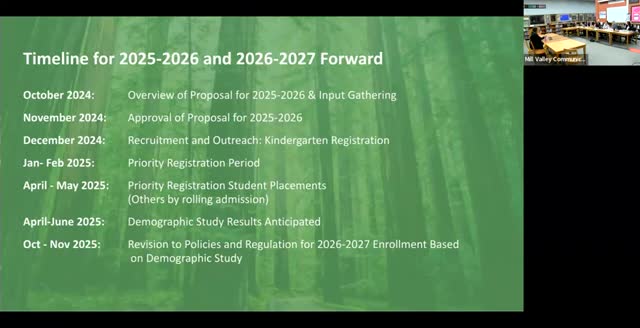Tam Valley parents demand transparency on class sizes and school placement policies
October 10, 2024 | Mill Valley Elementary, School Districts, California
This article was created by AI summarizing key points discussed. AI makes mistakes, so for full details and context, please refer to the video of the full meeting. Please report any errors so we can fix them. Report an error »

In a recent Mill Valley School District Board meeting, held on October 10, 2024, community members voiced their concerns about the district's interim placement process and class sizes, emphasizing the need for transparency and long-term solutions. The meeting, attended by a mix of in-person and online participants, highlighted the complexities surrounding school placements and the impact on families.
Anne Silcox, a parent of two young children at Tam Valley Elementary, expressed her worries about the district's approach to addressing school capacity. She urged the board to prioritize long-term solutions over what she described as a "rushed" interim proposal. Silcox emphasized that many families are confused about the implications of the current plan and called for clarity regarding classroom capacities and the definition of "small class sizes." She argued that maintaining appropriate class sizes is crucial for the quality of education, particularly in lower grades.
Jessica Iles, another concerned parent, raised questions about the kindergarten student-to-teacher ratio, noting discrepancies between the district's stated goals and actual classroom sizes. She sought clarification on the process for inter-district transfers and the criteria for class placements, highlighting the need for a more straightforward approach that considers the community's needs.
Scott Stillman, also a parent, echoed these sentiments, urging the board to retain proximity as a factor in the placement process. He warned that removing this consideration could alienate families and exacerbate existing issues related to class sizes. Stillman specifically advocated for adding a third class to the first grade at Tam Valley, a point that resonated with other attendees.
Erin Frazier, a fifth-grade teacher and co-president of the Mill Valley Teachers Association, called for greater transparency regarding class size policies and loading numbers. She pointed out significant discrepancies in class sizes across different schools and urged the board to communicate its plans clearly to the community.
As the meeting progressed, it became evident that parents and educators alike are seeking a collaborative approach to address the pressing issues of school capacity and class sizes. The discussions underscored a shared desire for a more cohesive strategy that aligns with the community's values and needs, particularly in maintaining strong connections between schools and their neighborhoods.
The board's commitment to listening to community feedback will be crucial as they navigate these challenges in the coming months. With ongoing concerns about educational quality and equity, the path forward will require careful consideration and a willingness to adapt to the needs of families in the Mill Valley School District.
Anne Silcox, a parent of two young children at Tam Valley Elementary, expressed her worries about the district's approach to addressing school capacity. She urged the board to prioritize long-term solutions over what she described as a "rushed" interim proposal. Silcox emphasized that many families are confused about the implications of the current plan and called for clarity regarding classroom capacities and the definition of "small class sizes." She argued that maintaining appropriate class sizes is crucial for the quality of education, particularly in lower grades.
Jessica Iles, another concerned parent, raised questions about the kindergarten student-to-teacher ratio, noting discrepancies between the district's stated goals and actual classroom sizes. She sought clarification on the process for inter-district transfers and the criteria for class placements, highlighting the need for a more straightforward approach that considers the community's needs.
Scott Stillman, also a parent, echoed these sentiments, urging the board to retain proximity as a factor in the placement process. He warned that removing this consideration could alienate families and exacerbate existing issues related to class sizes. Stillman specifically advocated for adding a third class to the first grade at Tam Valley, a point that resonated with other attendees.
Erin Frazier, a fifth-grade teacher and co-president of the Mill Valley Teachers Association, called for greater transparency regarding class size policies and loading numbers. She pointed out significant discrepancies in class sizes across different schools and urged the board to communicate its plans clearly to the community.
As the meeting progressed, it became evident that parents and educators alike are seeking a collaborative approach to address the pressing issues of school capacity and class sizes. The discussions underscored a shared desire for a more cohesive strategy that aligns with the community's values and needs, particularly in maintaining strong connections between schools and their neighborhoods.
The board's commitment to listening to community feedback will be crucial as they navigate these challenges in the coming months. With ongoing concerns about educational quality and equity, the path forward will require careful consideration and a willingness to adapt to the needs of families in the Mill Valley School District.
View full meeting
This article is based on a recent meeting—watch the full video and explore the complete transcript for deeper insights into the discussion.
View full meeting
